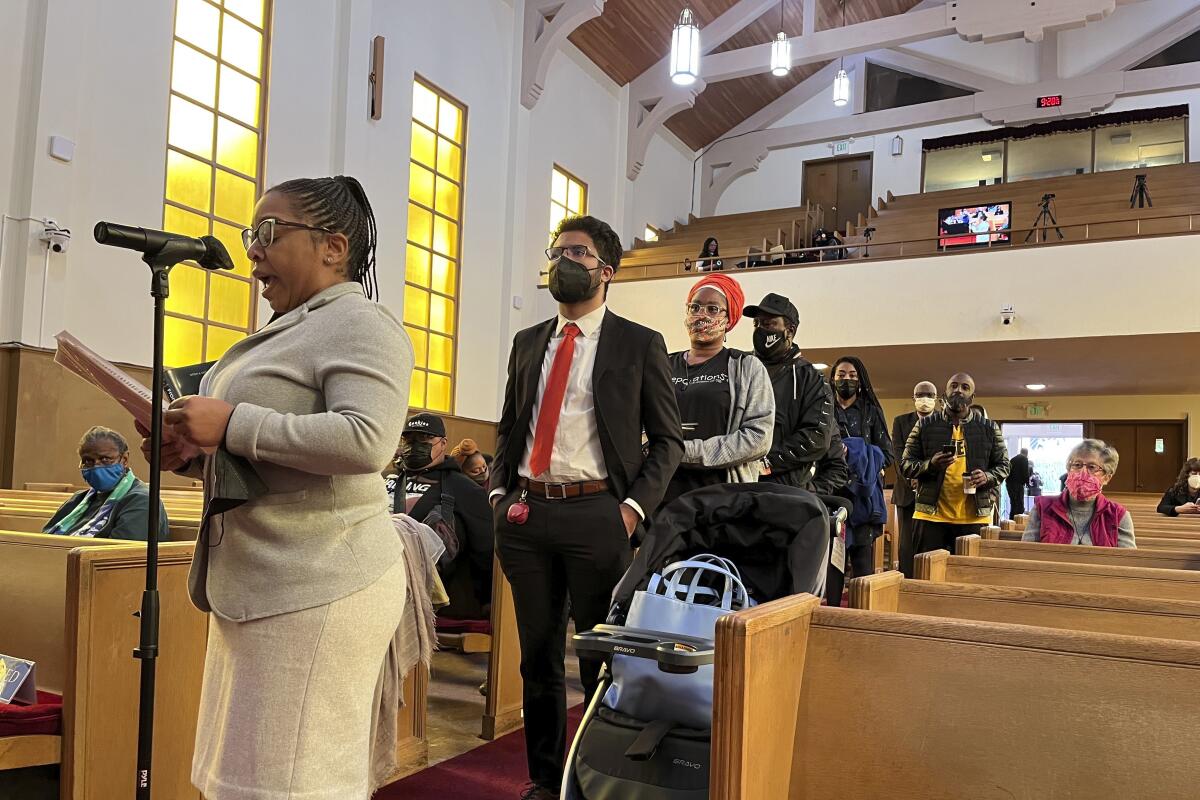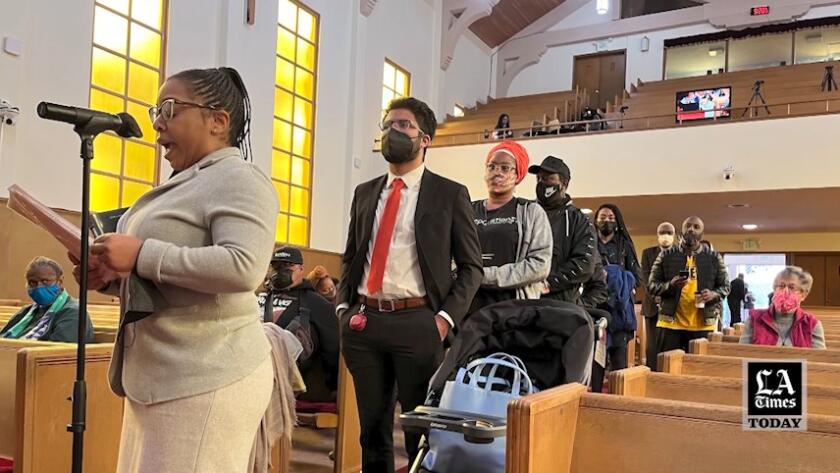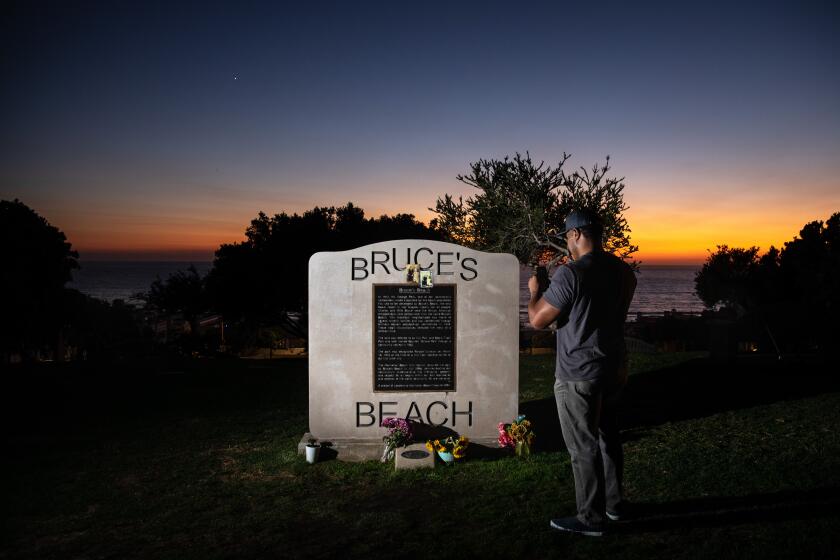California task force suggests reparations in report detailing lasting harms of slavery

- Share via
In a report Wednesday on the lingering effects of slavery, California’s Reparations Task Force offered a sweeping list of preliminary recommendations that include ending voter approval for publicly funded “low-rent housing,” providing free college tuition and creating a new state agency to implement dozens of other forms of reparation for African Americans.
The 492-page report is the first of two the nine-member panel will send to the California Legislature, which is responsible for passing any reparations into law. Much of the initial report focused on defining the harms against African Americans from slavery to present day as the basis for a detailed plan to provide remedies in a second installment next summer.
Kamilah Moore, chair of the task force, said she hopes people “pore into the report and read it with an open mind and an open heart to really understand the African American experience in the state.” She called it the most extensive government-issued report on the African American community in more than 50 years.
Legislation signed by Gov. Gavin Newsom in 2020 made California the first state government in the country to adopt a law to study and develop proposals for potential reparations to descendants of enslaved people and those affected by slavery.
The task force, composed of elected officials, civil rights leaders, attorneys and reparations experts, voted in March to tie eligibility to lineage, defined as “descendants of African Americans enslaved in the U.S. or of free Black people living in the country before the end of the 19th century.”
The report released Wednesday brings together much of the testimony the task force has heard over the last year from experts who described the extent to which federal, state and corporate policies led to continued discrimination against Black people in nearly all aspects of life after slavery was abolished.
Brothers want California to return land owned by their ancestors. But a task force’s debate over eligibility for reparations is complicating matters.
“In order to maintain slavery, government actors adopted white supremacist beliefs and passed laws to create a racial hierarchy and to control both enslaved and free African Americans,” the report states.
The document is broken down into 13 chapters that delve into different forms of discrimination, such as racial terror, political disenfranchisement, housing segregation and separate-and-unequal education. Each chapter offers separate sections describing harms at the state and federal level.
“Essentially the purpose of that is to make clear how California and the localities within the state have been complicit in perpetuating the harms against the African American community,” Moore said.
The task force’s findings in the report detail how American slavers trafficked African Americans to California, particularly in the gold rush era that began in 1848. Many were forced to separate from their families and friends by thousands of miles. More than three-quarters were young men or teenage boys who often took on difficult work as gold miners. Women and girls who were trafficked to California worked as servants, housemaids and cooks.
- Share via
Watch L.A. Times Today at 7 p.m. on Spectrum News 1 on Channel 1 or live stream on the Spectrum News App. Palos Verdes Peninsula and Orange County viewers can watch on Cox Systems on channel 99.
Census records show 178 enslaved African descendants lived in California in 1852, but other estimates suggest that was an undercount and the actual population was closer to 1,500.
“In 1850, one slaveholder beat an enslaved man in the town square of San Jose for disobeying him,” the report says. “The police arrested both men, but ultimately determined that the slaveholder was not guilty of assault because his victim was legally his property.”
Though California banned slavery in its 1849 Constitution, the state had no laws that made it a crime to keep someone enslaved or require them to be freed, which allowed slavery to continue. A disproportionate representation of white Southerners with pro-slavery views held office in the Legislature, state court system and in its congressional delegation, advancing laws such as California’s Fugitive Slave Law of 1852, which authorized slaveholders to use violent means to capture enslaved people who arrived in California before its statehood and escaped, or refused to return to slave states with their enslaver.
Racial hierarchy continued to take root in California and beyond when slavery was abolished federally by the 13th Amendment in 1865. In the 1920s, the Ku Klux Klan established chapters all over the state with members in prominent government positions, including top leadership positions in Los Angeles, according to the report.
“Supported by their government, ordinary citizens also terrorized and murdered Black Californians,” the report says.
Gov. Gavin Newsom has authorized the return of property known as Bruce’s Beach to the descendants of a Black couple that had been run out of Manhattan Beach almost a century ago. Catch up on The Times’ coverage.
The state barred people of color from providing court testimony against white people in 1850: “The California Supreme Court explained that any non-white person to testify ‘would admit them to all the equal rights of citizenship, and we might soon see them at the polls, in the jury box, upon the bench, and in our legislative halls,’ a prospect that the court viewed as an ‘actual and present danger.’”
Through redlining, zoning, mortgage policies and the construction of schools and highways, all levels of government segregated Black Californians. Racial covenants, in which white people in a neighborhood agreed not to sell their homes to people of color, continued in the 1940s, the report says.
In education, according to the report, “California remains the sixth most segregated state in the country for Black students,” with schools attended by white and Asian children receiving more funding than those attended by Black and Latino children.
The task force included several preliminary recommendations for addressing those harms, which Moore said she hopes lawmakers review and consider acting upon before the second report comes out next year.
Proposed suggestions include providing free tuition for California colleges and universities as well as funding for Black-owned and -controlled schools.
The panel suggested ending work requirements for California inmates and paying them market rate for their labor. To address police violence against Black people, the task force is proposing holding law enforcement officers more accountable.
The group is also recommending a repeal of Article 34 of the California Constitution, approved in 1950 to require voter approval to develop, construct or acquire low-income housing funded by the government, and ending crime-free housing rules that disproportionately affect Black residents.
Under a new California African American Freedmen Affairs Agency, the report recommends the creation of a Cabinet-level secretary to implement the task force’s recommendations and work with state governments to “eliminate systemic racism that has developed as a result of the enslavement.”
“The hope is that what we’re doing in California becomes a framework for the national level,” Moore said.
More to Read
Sign up for Essential California
The most important California stories and recommendations in your inbox every morning.
You may occasionally receive promotional content from the Los Angeles Times.














